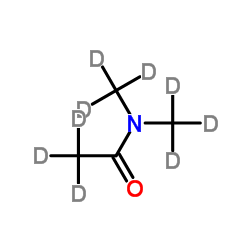16727-10-9
| 中文名 | 二甲基乙酰胺-D9 |
|---|---|
| 英文名 | 2,2,2-trideuterio-N,N-bis(trideuteriomethyl)acetamide |
| 英文别名 |
Acetamide-d, N,N-di(methyl-d)-
DE790 nonadeuterio-dimethylacetamide deutero N,N-dimethylacetamide Perdeutero-N,N-dimethyl-acetamid 2,2,2-trideuterio-N,N-bis-trideuteriomethyl-acetamide N,N-Bis[(H)methyl](H)acetamide nonadeutero-N,N-dimethylacetamide |
| 描述 | N、 N-二甲基乙酰胺-d9是氘标记的N,N-二甲基甲酰胺[1]。N、 N-二甲基乙酰胺(DMAc)是一种廉价、常见的非质子有机溶剂[2]。 |
|---|---|
| 相关类别 | |
| 体外研究 | 氢、碳和其他元素的稳定重同位素已被掺入药物分子中,主要作为药物开发过程中定量的示踪剂。头韵因其可能影响药物的药代动力学和代谢特征而受到关注[1]。 |
| 参考文献 |
| 密度 | 0.9±0.1 g/cm3 |
|---|---|
| 沸点 | 166.1±0.0 °C at 760 mmHg |
| 分子式 | C4H9NO |
| 分子量 | 96.176 |
| 闪点 | 70.0±0.0 °C |
| 精确质量 | 96.124908 |
| PSA | 20.31000 |
| LogP | -0.75 |
| 蒸汽压 | 1.8±0.3 mmHg at 25°C |
| 折射率 | 1.407 |
| 计算化学 | 1.疏水参数计算参考值(XlogP):无 2.氢键供体数量:0 3.氢键受体数量:1 4.可旋转化学键数量:0 5.互变异构体数量:无 6.拓扑分子极性表面积:20.3 7.重原子数量:6 8.表面电荷:0 9.复杂度:58.6 10.同位素原子数量:9 11.确定原子立构中心数量:0 12.不确定原子立构中心数量:0 13.确定化学键立构中心数量:0 14.不确定化学键立构中心数量:0 15.共价键单元数量:1 |
Synonym: Section 2 - COMPOSITION, INFORMATION ON INGREDIENTS
Risk Phrases: 20/21 61 Section 3 - HAZARDS IDENTIFICATION EMERGENCY OVERVIEW
Harmful by inhalation and in contact with skin. May cause harm to the unborn child.Hygroscopic (absorbs moisture from the air). Potential Health Effects The toxicological properties of this material have not been investigated. Use appropriate procedures to prevent opportunities for direct contact with the skin or eyes and to prevent inhalation. Section 4 - FIRST AID MEASURES Eyes: Immediately flush eyes with plenty of water for at least 15 minutes, occasionally lifting the upper and lower eyelids. Skin: Flush skin with plenty of water for at least 15 minutes while removing contaminated clothing and shoes. Ingestion: Do NOT induce vomiting. If conscious and alert, rinse mouth and drink 2-4 cupfuls of milk or water. Inhalation: Remove from exposure and move to fresh air immediately. Notes to Physician: Section 5 - FIRE FIGHTING MEASURES General Information: As in any fire, wear a self-contained breathing apparatus in pressure-demand, MSHA/NIOSH (approved or equivalent), and full protective gear. During a fire, irritating and highly toxic gases may be generated by thermal decomposition or combustion. Extinguishing Media: In case of fire, use water, dry chemical, chemical foam, or alcohol-resistant foam. Section 6 - ACCIDENTAL RELEASE MEASURES General Information: Use proper personal protective equipment as indicated in Section 8. Spills/Leaks: Absorb spill with inert material (e.g. vermiculite, sand or earth), then place in suitable container. Clean up spills immediately, observing precautions in the Protective Equipment section. Sweep up, then place into a suitable container for disposal. Section 7 - HANDLING and STORAGE Handling: Wash thoroughly after handling. Remove contaminated clothing and wash before reuse. Avoid contact with eyes, skin, and clothing. Avoid ingestion and inhalation. Storage: Store in a cool, dry place. Keep container closed when not in use. Section 8 - EXPOSURE CONTROLS, PERSONAL PROTECTION Engineering Controls: Use adequate general or local exhaust ventilation to keep airborne concentrations below the permissible exposure limits. Use process enclosure, local exhaust ventilation, or other engineering controls to control airborne levels. Exposure Limits CAS# 16727-10-9: Personal Protective Equipment Eyes: Not available. Skin: Wear appropriate protective gloves and clothing to prevent skin exposure. Clothing: Wear appropriate protective clothing to minimize contact with skin. Respirators: Wear a NIOSH/MSHA or European Standard EN 149 approved full-facepiece airline respirator in the positive pressure mode with emergency escape provisions. Section 9 - PHYSICAL AND CHEMICAL PROPERTIES Physical State: Liquid Color: Not available. Odor: Not available. pH: Not available. Vapor Pressure: Not available. Viscosity: Not available. Boiling Point: 165 deg C @ 760.00mmHg Freezing/Melting Point: 0 deg C Autoignition Temperature: Not available. Flash Point: 70 deg C ( 158.00 deg F) Explosion Limits, lower: Not available. Explosion Limits, upper: Not available. Decomposition Temperature: Solubility in water: soluble Specific Gravity/Density: 1.0400g/cm3 Molecular Formula: Molecular Weight: Section 10 - STABILITY AND REACTIVITY Chemical Stability: Stable under normal temperatures and pressures. Conditions to Avoid: Strong oxidants. Incompatibilities with Other Materials: Not available. Hazardous Decomposition Products: Nitrogen oxides, carbon monoxide, irritating and toxic fumes and gases, carbon dioxide, hydrogen bromide, nitrogen. Hazardous Polymerization: Has not been reported. Section 11 - TOXICOLOGICAL INFORMATION RTECS#: CAS# 16727-10-9 unlisted. LD50/LC50: Not available. Carcinogenicity: N,N-Dimethylacetamide-d9, 99+ atom% d - Not listed by ACGIH, IARC, or NTP. Section 12 - ECOLOGICAL INFORMATION Section 13 - DISPOSAL CONSIDERATIONS Dispose of in a manner consistent with federal, state, and local regulations. Section 14 - TRANSPORT INFORMATION IATA Not regulated as a hazardous material. IMO Not regulated as a hazardous material. RID/ADR Not regulated as a hazardous material. Section 15 - REGULATORY INFORMATION European/International Regulations European Labeling in Accordance with EC Directives Hazard Symbols: T Risk Phrases: R 61 May cause harm to the unborn child. R 20/21 Harmful by inhalation and in contact with skin. Safety Phrases: S 26 In case of contact with eyes, rinse immediately with plenty of water and seek medical advice. S 28A After contact with skin, wash immediately with plenty of water. S 36 Wear suitable protective clothing. WGK (Water Danger/Protection) CAS# 16727-10-9: No information available. Canada None of the chemicals in this product are listed on the DSL/NDSL list. CAS# 16727-10-9 is not listed on Canada's Ingredient Disclosure List. US FEDERAL TSCA CAS# 16727-10-9 is not listed on the TSCA inventory. It is for research and development use only. SECTION 16 - ADDITIONAL INFORMATION N/A |


